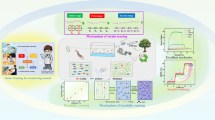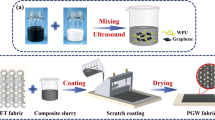Abstract
Many instruments and sensors have been invented to measure pressure, with different advantages and disadvantages. Many factors like pressure range, accuracy, sensitivity, reproducibility, dynamic response, and cost are involved in developing a pressure measuring device. This research paper describes the study of variation in the dielectric constant of lead iron tungstate relaxor specimens with pressure and temperature. In this study, the investigator optimized the specimen's preparation method by changing calcination temperature, adding excess lead oxide, using conventional mixed oxides and columbite routes to improve the specimen's pressure-sensing properties. This study adds another pressure-sensing application of relaxor materials among many other applications.








Similar content being viewed by others
References
A.S. Morris and R. Langari, Measurement and instrumentation: theory and application, 2nd edn., Elsevier (2016), pp. 463–487.
M. Yonezawa, Low-firing multilayer capacitor materials. Am. Ceram. Soc. Bull., 62 (1983) 1375–1383.
S. Nomura and K. Uchino, Recent applications of PMN based electrostrictors. Ferroelectrics, 50 (1983) 197–202.
D.A. Ciubotariu, I.A. Ivanb, C. Clévy and P. Lutza, Piezoelectric 3D actuator formicro-manipulation based on [011]-poled PMN-PT single crystal. Sens. Actuat. A, 252 (2016) 242–252.
Z.Y. Cheng, R.S. Katiyar, X. Yao and G. Aquiang, Dielectric behavior of magnesium niobate relaxors. Phys. Rev. B, 55 (1997) 8165–8174.
J. Kwata, K. Uchino and S. Nomura, Diffuse phase transition in lead zinc niobate. Ferroelectrics, 22 (1979) 863–867.
N. Mizutani, C.H. Lu, K. Shinozaki and M. Kato, Formation of high temperature liquid phase during the sintering of PFW. J. Am. Ceram. Soc., 73 (1990) 214–1220.
T. Hachiga, S. Fujimoto and N. Yasuda, The pressure and temperature dependent dielectric properties of PCN. J. Phys. D Appl. Phys., 20 (1987) 1291–1296.
A.A. Bokov and V.Y. Shonov, Dielectric properties and diffusion of ferroelectric phase transition in lead indium niobate. Ferroelectrics, 108 (1990) 237–240.
N. Setter and L.E. Cross, pressure dependence dielectric properties of PST. Phys. Stat. Sol., 61 (1980) 71–75.
S.L. Swartz, T.R. Shrout, W.A. Schulze and L.E. Cross, Dielectric properties of lead‐magnesium niobate ceramics. J. Am. Ceram. Soc., 67 (1984) 311–315.
T.R. Shrout and A. Halliyal, Preparation of lead-based ferroelectric relaxors for capacitors. Am. Ceram. Soc. Bull., 66 (1987) 704–711.
M. Lejeune and J.P. Boilot, Low firing dielectrics based on lead magnesium niobate. Mater. Res. Bull., 20 (1985) 493–499.
M. Lejeune and J.P. Boilot, Optimisation of dielectric properties of lead magnesium niobate ceramics. Am. Ceram. Soc. Bull., 65 (1986) 679–682.
P. Papet, J.P. Dougherty and T.R. Shrout, Particle and grain size effects on the dielectric behavior of the relaxor ferroelectric PMN. J. Mater. Res., 5 (1990) 2902–2909.
D. Viehland, S.J. Jang, L.E. Cross and M. Wuttig, Freezing of the polarization fluctuations in lead magnesium niobate relaxors. J. Appl. Phys., 68 (1990) 2916–2921.
M. Avdeev, J.D. Jorgensen, S. Short, G.A. Samara, E.L. Venturini, P. Yang and Morosin B, Pressure-induced ferroelectric to antiferroelectric phase transition in PZTN. Phys. Rev. B, 73 (2006) 064105(1–14).
J.L. Zhu, S. Lin, S.M. Feng, F.Y. Lil, L.J. Wang, C.Q. Jin, X.H. Wang and L.T. Li, The effects of high pressure on the ferroelectric properties of nano-BaTiO3 ceramics. J. Phys. Conf. Ser., 121 (2008) 162005(1–9).
N. Yasuda and Y. Ueda, Dielectric properties of PFN under pressure. Ferroelectrics, 95 (1989) 147–151.
M.V.R. Rao, A.M.U. Ji, K.K. Jain and E.S.R. Gopal, Effect of high pressure on the dielectric properties of relaxor compositions PFN-PZN-BT. J. Mater. Sci. Lett., 16 (1997) 122–125.
Y. Kumar, V. Kumar, K.K. Jain and S.C. Kashyap, A capacitive pressure gauge as a reliable transfer pressure standards. Sens. Actuat. B, 55 (1999) 217–221.
K. Uchino, S. Nomura, L.E. Cross, S. Jang and R.E. Newnham, Electrostrictive effect in lead magnesium niobate single crystals. J. Appl. Phys., 51(1980) 1142–1145.
K. Uchino, S. Nomura, L.E. Cross, S. Jang and R.E. Newnham, Pressure gauge using relaxor ferroelectrics. Jpn. J. Appl. Phys., 20 (1981) L367–L370.
V. Kumar and S. Yadav, Studies on use of lead iron tungstate-lead titanate relaxor binary system as a pressure sensing material. Sens. Actuators A, 258 (2017) 101–104.
C. Andeen, J. Fontanella and D. Schuele, A capacitive gauge for the accurate measurement of high pressures. Rev. Sci. Inst., 42 (1971) 495–496.
Y. Yokotani, J. Kato, M. Nishida, S. Kawashima and H. Ouchi, Dielectric properties of PMN-PZN-PFW. Jpn. J. Appl. Phys., 24 (1985) 93–95.
G.F. Chen and S.L. Fu, Fabrication of perovskite PFW-PFN-PT by double calcination process. J. Mater. Sci., 23 (1988) 3258–3262.
N. Yasuda, S. Fujimoto and K. Tanaka, Dielectric properties of PFW under pressure. J. Phys. D. Appl. Phys., 18 (1985) 1909–1917.
C.H. Lu, K. Shinozaki and N. Mizutani, Formation process and microstructural evolution of sol-gel-derived ferroelectric lead iron tungstate ceramics. J. Am. Ceram. Soc., 75 (1992) 1303–1306.
T.C. Reiley, J.V. Badding, D.A. Payne and D.A. Chance, A low firing thick film capacitor material based on lead iron niobate/tungstate. Mater. Res. Bull., 9 (1984) 1543–1549.
L. Zhou, P.M. Vilarinho and J.L. Batista, Stoichiometry dependence of the aging phenomena in lead iron tungstate ceramic. J. Am. Ceram. Soc., 79 (1996) 2436–2342.
L. Zhou, P.M. Vilarinho and J.L. Batista, Dielectric properties and aging effects of manganese modified lead iron tungstate relaxor ceramics. Mater. Res. Bull., 31 (1996) 699–708.
L. Zhou, P.M. Vilarinho and J. Batista, Synthesis and characterization of lead iron tungstate ceramics obtained by two preparation methods. Mater. Res. Bull., 29 (1994) 1193–1201.
S.L. Swartz and T.R. Shrout, Fabrication of perovskite lead magnesium niobate. Mater. Res. Bull., 17 (1982) 1245–1250.
K. Uchino and S. Nomura, Dielectric and magnetic properties in the solid solution system PFW-PCW. Ferroelectrics, 17 (1978) 505–510.
N. Yasuda, S. Fujimoto, K. Tanaka and T. Hachiga, Pressure and temperature dependence of dielectric properties of cadmium niobate. J. Phys. D Appl. Phys., 17 (1984) 2069–2079.
K.K. Jain and S.C. Kashyap, Pressure and temperature dependent dielectric dispersion in BGO (100) single crystals. Bull. Mater. Sci., 19 (1996) 533–537.
S. Yadav, O. Prakash, V.K. Gupta and A.K. Bandyopadhyay, The effect of pressure-transmitting fluids in the characterization of a controlled clearance piston gauge up to 1 GPa. Metrologia, 44 (2007) 222–233.
Proceedings, Joint International Conference on Force, Mass, Torque, Hardness and Civil Engineering Metrology IMEKO TC3/TC5/TC20, 23 –27 September 2002. Celle, Germany.
JCGM 100:2008 GUM 1995 with minor corrections, Evaluation of measurement data—Guide to the expression of uncertainty in measurement. Available from www.bipm.org.
Acknowledgements
I want to express my deep gratitude to Dr. Sanjay Yadav HOD, Physico-Mechanical Metrology Division, CSIR-NPL, India, for his advice and assistance in keeping my progress on schedule.
Author information
Authors and Affiliations
Corresponding author
Additional information
Publisher's Note
Springer Nature remains neutral with regard to jurisdictional claims in published maps and institutional affiliations.
Rights and permissions
About this article
Cite this article
Kumar, V. Studies on Optimization of Preparation Methods of Lead Iron Tungstate Relaxor to Use as a Pressure Sensing Material. MAPAN 36, 305–311 (2021). https://doi.org/10.1007/s12647-021-00470-0
Received:
Accepted:
Published:
Issue Date:
DOI: https://doi.org/10.1007/s12647-021-00470-0




